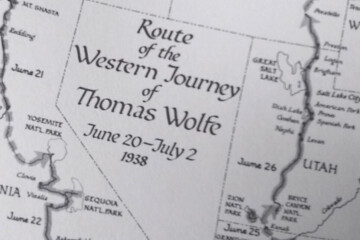Sidney Edgerton: Father of Montana?
Look at a map of the western United States. Almost all of the borders are straight lines. Some of the states are nearly square; Wyoming and Colorado definitely, North and South Dakota nearly, New Mexico and Utah, close. Rivers form some boundaries: the Missouri, Colorado, Columbia, Snake. Only one border is different, that between Montana and Idaho. From Yellowstone to the west the border follows the Continental Divide. At Lost Trail Pass as the Divide heads northeast, the state border moves in exactly the opposite direction, southwest. It follows the crest of the Bitterroot Range and then the Coeur d Alene mountains to the Clark Fork River, where it straight lines to Canada. The truth is that Idaho is a rather strangely shaped state with its panhandle just about 50 miles wide at the border.
The area that became Montana was at various times a part of the Louisiana Purchase, Unorganized Indian Territory, Oregon Territory, Nebraska Territory, Dakota Territory, Washington Territory, and Idaho Territory. The Idaho Territory (the area which became the states of Idaho, Wyoming, and Montana) was created in 1863. President Abraham Lincoln named William Wallace governor and Sidney Edgerton chief justice. Lewiston was designated the capital.
Governor Wallace briefly performed his duties, then was elected the Territorial Delegate to Congress, resigning the governorship. Those duties included assigning districts to the federal judges. Wallace did not believe in importing judges from the east. Edgerton was from Ohio. Wallace assigned him to the eastern district. Edgerton set off from Washington, D.C. to report and be sworn in. He traveled by boat and train as far as Omaha, where his party embarked in ox-drawn wagons. By 1863 emigrants had been traveling the Oregon Trail for twenty years, yet the hardships were the same. At Fort Laramie, Edgerton was officially within the newly formed Idaho Territory, yet was still 1000 miles from Lewiston. They proceeded on. By September the Edgerton party, which included his pregnant wife, realized that arriving at Lewiston to report to the Governor before snowfall was not possible. They altered course for Edgerton’s district. The main settlement was the gold rush town of Bannack. There were no other officials there, so he was never sworn in as chief justice. He awaited instructions. They never came. Edgerton, having no official duties, spent his time as an observer to the miners’ court, which was practicing vigilante justice. He was present for the trials and hangings of Sheriff Henry Plummer and his deputies. Wilbur Sanders, who was Edgerton’s nephew and had traveled with him over the trail, was one of the original organizers of the Alder Gulch Vigilance Committee.
In the wake of the violence that had inspired the vigilantes, it was recognized that neither the United States nor the Idaho Territory were providing the area with any protection or government. Edgerton had no official authority. The miners and settlers had organized themselves. Sentiment developed to break away from faraway Lewiston, (that capital was soon moved to Boise) and petition for a separate territory. Prior to accepting his post, Edgerton had been a congressman from Ohio. His friend and fellow Ohio congressman James Ashley was chairman of the House committee on Territories. Edgerton was asked by the citizens to return to Washington to present the case of the people of the settlements of Bannack and Alder Gulch.
Edgerton and his nephew Sanders, who was also his law partner, departed Bannack for Salt Lake in January, 1864. It was the middle of a severe winter; they left their families behind, so the situation must have been considered serious. In a clever stroke of marketing for their cause, they took with them a quantity of large gold nuggets, which caused a stir when they showed them in Congress. Two months later, Ashley presented a bill to create a separate territory.
It is remarkable that this group of Ohio politicians—Ashley, Edgerton, and Sanders—had established Montana as an independent Territory little more than a year after the Idaho Territory was formed. Another fact is just short of amazing. The Continental Divide had been part of the boundary between the Washington Territory and the Dakota Territory as recently as 1861. This was a natural line, and when the Idaho Territory was proclaimed, it remained. Edgerton and Ashley were able to shift this boundary hundreds of miles to the west to include in the Montana Territory the Flathead and Bitterroot Valleys. Butte, Missoula, Kalispel, Flathead Lake, and more than half of Glacier Park could have ended up in Idaho. There were few settlements in the area, most of the gold strikes were farther east or westward, toward Lewiston and Boise. This was a gift of 27,000 square miles.
Was Edgerton’s motive a payback for the disrespect he received from William Wallace? Did he care enough about the future of Montana to want advantages for the Territory? He had left his family in Bannack and lobbied to become the first Territorial governor, so he was committed. In 1863, Edgerton had gone west, not knowing his destination. He received word while traveling that Lewiston had been named the capital. Circumstances made him detour to Bannack. In 1864, he once again began his journey west in uncertainty. He had personally lobbied Lincoln for the job of Territorial Governor, but no decision had been reached when he set off. Word reached the party at Salt Lake of the appointment of Sidney Edgerton as the first Territorial Governor of Montana.
It is tempting to think of the fate of Montana and Idaho being decided by Edgerton and Ashley in a congressional office poring over a map, possibly one drawn by William Clark decades previously. It is highly likely that there were other persons and factors involved. Granville and James Stuart had settled in the Deer Lodge valley west of the Divide in the 1850s. They had connections with the gold rush towns, and interests farther east. The Jesuits had been active in the west as missionaries since the 1840s. Father De Smet and Father Ravalli had established missions in the Bitterroot Valley and at St Ignatius. These men and their efforts on behalf of the Native Americans were well known in Washington, D.C. Most significant may have been Major John Owen. He had established a trading fort in the Bitterroot in the 1850s. He also traveled to the Capital in the winter of 1864 to help with the lobbying effort. Though a Democrat, he was acquainted with President Lincoln, whose journal mentions receiving a thank you note from Edgerton for personally delivering his application for the territorial governorship to the President. Whichever politics and personalities were involved, success was achieved.
Edgerton arrived back in Bannack in midsummer, having been gone for six months. He had accomplished his goal of the creation of an independent territory and set about its organization. The reaction of the citizenry to the name Montana and the extended boundary is not known. The news that these people were now their own masters was welcomed. Officials were appointed, counties designated, a census undertaken. The rest of 1864 into 1865 must have been an exciting time. Yet, there were problems, and the most serious were political.
The Civil War still raged. In the newly formed Montana Territory, Democrats constituted a large majority, including Northerners and Southern sympathizers, even ex-confederates. The officials were all Republicans, as were both the Administration and Congress in Washington, D.C. These divisions proved militant, even violent. Edgerton’s daughter reminisced that there were threats to anyone displaying the “star spangled banner... drunken horsemen galloping by at night often firing random shots at the red, white and blue target while hurrahing lustily for Jeff Davis.” Most of the conflicts, however, were oratorical. The Republicans declared all Democrats to be traitors, and Democrats held rallies calling for a negotiated end to the War. In the initial territorial elections, the Democrats held a majority. Edgerton and his nephew Sanders, who ran for delegate to congress but was defeated by a Democrat, were as radical in condemning their opposition as those who opposed them.
Still, Edgerton announced an ambitious program including roads, education, mail delivery, Indian affairs, and mineral taxation. The politics were definitely abrasive but much work was done. Elections were held, officials appointed, counties divided, organized, and named. The original counties were; Missoula, Madison, Jefferson, Gallatin, Deer Lodge, Custer, Choteau, Beaverhead, and Edgerton, named for the governor.
The politics were raucous and the administration was precarious. The charter of the Territory (The Organic Act) called for a Secretary in addition to the governor. The secretary was to approve all expenditures and submit the invoices to the U.S. government for payment—but there was no secretary. The job had been offered to at least two individuals but no one had accepted. For over a year, there were no funds, so Sidney Edgerton spent a great deal of his own money. Communication with Washington was difficult. The telegraph line had not yet been extended to Montana; the nearest site was Salt Lake. Once again, Sidney Edgerton decided to make the trip east to plead his cause.
Ironically, just before his departure, the newly appointed secretary for the territory arrived. Governor Edgerton left anyway. His stated reasons were to arrange for the education of his children in Ohio, in addition to conducting territorial business in Washington, D.C. Perhaps he also was weary of the fruitless politics of Montana. In any event, in less than a year, without having returned west, he resigned from his position as the first Territorial Governor of Montana. The secretary became the acting governor as soon as Edgerton left. This was Thomas Meagher, the most flamboyant character of the early days of Montana government. He was an exiled Irish patriot, a Civil War hero, and a bigger than life personality. Most of what he attempted to accomplish as acting governor was later declared unconstitutional. He died under mysterious circumstances at Fort Benton in 1867. There is a county named Meagher. There is a large bronze statue of Thomas Meagher on horseback brandishing a sword in front of the state capitol in Helena.
Sidney Edgerton lived the rest of his life in Ohio, practicing law. He returned once to Montana many years later for a visit. Soon after his departure in 1865, the Democratic legislature changed the name of Edgerton County to Lewis and Clark County. The man who was responsible for the establishment of the territory that became the state of Montana, the man who could be legitimately called the Father of Montana, has been largely forgotten.




